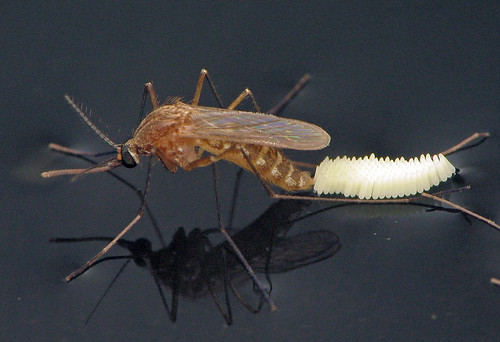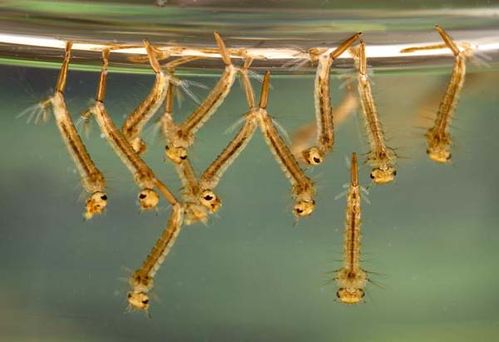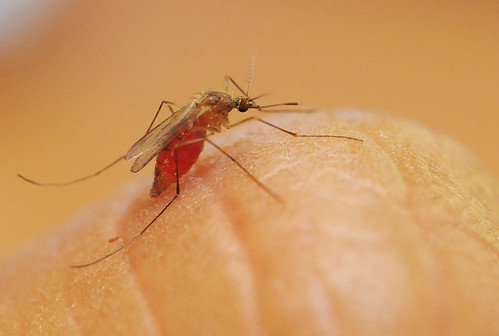Culex quinquefasciatus
Culex quinquefasciatus
Culex quinquefasciatus
Culex quinquefasciatus
Culex quinquefasciatus
- Taxonomic name: Culex quinquefasciatus Say, 1823
Synonyms: Culex pungens
Common names: southern house mosquito (English)
Organism type: insect
- The mosquito Culex quinquefasciatus is one of the most common and widespread members of the Culex pipiens (Cx. pipiens) complex, which includes vectors of St. Louis encephalitis virus, West Nile virus, Rift Valley fever virus and bird malarias such as Plasmodium relictum. This mosquito is brown with cross veins on narrow wings and narrow cross bands on the abdomen, which is blunt at the tip. From the fifteenth century to the present, successive waves of invasion of vector mosquitoes have been facilitated by worldwide ship transport. Mosquito borne diseases are likely to be spread by local and long-distance air travel unless control measures are implemented. C. quinquefasciatus poses a risk to avifauna in isolated island ecosystems such as those in the Hawaiian and Galapagos archipelago.
- Description
The adult C. quinquefasciatus is less than 3/16 inch long. They are brown with narrow cross bands on the abdomen; they have no white bands on the legs and their abdomen is blunt at the tip. Larvae are recognized by their long breathing tubes and whip-like tail movements when disturbed (DuPonte & Larish, 2003).The distinguishing features of the Culex mosquitoes are: cross veins on narrow wings, blunt abdomen, short palpus, and no prespiracular or postspiracular setae (CDC 2005).
Accurate identification of species is needed to target mosquito control more effectively (Apperson et al. 2002). Enzyme electrophoresis as a genetic tool to distinguish between Cx. pipiens and Cx. quinquefasciatus should be used with caution (Cornel et al. 2002).
- Occurs in:
ruderal/disturbed
- General impacts
Collectively, members of the Cx. pipiens complex represent the most important Culex species from a medical and veterinary standpoint because they are vectors of St. Louis encephalitis virus in eastern and south central North America (Tsai and Mitchell 1989), West Nile virus in northeastern United States (Lanciotti et al. 2000) and Europe (Hubalek and Halouzka 1999), Rift Valley fever virus (Meegan 1979), Wuchereria bancrofti (Farid et al. 2001), Dirofilaria immitis (Lai et al. 2000), and bird malarias such as Plasmodium relictum (Atkinson et al. 1995, in Cornel et al. 2002).
West Nile viral encephalitis is a zoonosis and people and horses are incidentally infected with the virus by mosquitoes that feed on both avian and mammalian hosts (Komar 2000, in Apperson et al. 2002). As Culex spp. actively search for blood hosts during the nighttime hours people are more susceptible to biting by mosquitoes during the night (Apperson et al. 2002). In Hawaii C. quinquefasciatus is a cyclopropagative vector (in which the pathogen undergoes further development and multiplication) for avian malaria, and a mechanical vector (in which the pathogen is carried on or in mouthparts and legs) for avian pox. The endemic birds of Hawaii are more susceptible to both of these pathogens than are introduced birds (Atkinson et al. 2000, Yorinks & Atkinson 2000, Van Riper et al. 2002).
- Notes
The taxonomic status of the members of the Culex pipiens (Cx. pipiens) complex is controversial. Cx. pipiens, Cx. quinquefasciatus and Cx. molestus are the most common and widespread of the members of the complex (Cornel et al. 2002).
- Geographical range
Native range: Native to North America.
Known introduced range: It is found throughout the tropics and subtropics, including virtually all the island groups in the Pacific.
- Introduction pathways to new locations
Aircraft: Local air travel occurs among the three islands within the Galapagos archipelago (Islas Isabela, Santa Cruz and San Cristobal) and new mosquito borne diseases are likely to be introduced unless control measures are implemented for aircraft flying into the archipelago (A.M. Kilpatrick et al., in Whitman et al. 2005).
Seafreight (container/bulk): Ships, especially modern container vessels (Reiter 1998, Reiter and �Darsie 1984, in Lounibos, 2002), can carry a large number of propagules, especially of the immature stages, of mosquitoes.
- Management information
Preventative measures: Reducing the number of potential water catchments (mosquito breeding sites) helps reduce populations of mosquitoes, and reducing pig numbers reduces potential mosquito populations. In Hawaii, the introduction of pigs into forest areas has increased the number of potential breeding areas for mosquitoes. In foraging pigs will often fell tree ferns and create trough-like depressions that fill with rainwater. Mosquitoes have been found in greater abundance in these pig-infested areas than elsewhere. Thus, excluding pigs from conservation areas or eradicating them from forested areas reduces the number of potential mosquito breeding areas.Chemical: The approach most commonly used to control mosquito vectors is the application of insecticides (McCarroll and Hemingway 2002, in Liu et al. 2005). However, diverse resistance mechanisms and multiple mechanisms acting in concert often evolve in mosquitoes, making them resistant to insecticide (Brengues et al,. 2003, in Liu et al. 2005). Members of the Cx. pipiens complex have a notorious reputation for developing resistance to insecticides, including organophosphates (OPs), carbamates (Hemingway and Karunaratne 1998), pyrethroids (Bisset et al. 1991, Ben Cheikh et al. 1998, Chandre et al. 1998, Kasai et al. 1998), and Bacillus sphaericus (Nielsen-Leroux et al. 1997, Yuan et al. 2000). Where the control of mosquitoes via insecticide application (of OPs or pyrethroids) has proved insufficient to manage them effectively (due to the evolution of resistant strains) it has been found that increasing the dosage and frequency of insecticide applications and/or changing to different insecticides may help (Liu et al. 2005).
Biological: Given their ability to develop insecticide resistance, the evolution and spread of resistance genes among members of the Cx. pipiens complex across continents has become a topic of considerable applied and basic scientific interest (Raymond et al. 1991, Callaghan et al. 1998, Small et al. 1999, in Cornel et al. 2002).
The bacterium Bacillus thuringiensis subsp. israelensis was discovered in the mid-1970s in Israel (Goldberg and Margalit 1977), and was shown to be highly effective in controlling the larvae of numerous species of mosquitoes. This high efficacy quickly led to development of BTI as the active ingredient for commercial bacterial larvicides (Mulla 1990). These larvicides are now used routinely in vector control programs around the world. Despite its intensive use in many control programs, there are no reports of resistance to BTI (Wirth Walton and Federici 1999).
Bacterial larvicides based on commercial formulations of B. sphaericus 2362 are used in several countries and resistance in field populations of Cx. quinquefasciatus has been reported in France, Brazil and India (Sin�gre et al. 1994, Silva-Filha et al. 1995, Rao et al. 1995, in Wirth Walton and Federici 1999). Wirth Walton and Federici (1999) found that adding Cyt1A (from Bacillus thuringiensis subsp. israelensis) at a ratio as low as 1:10 to B. sphaericus larvicides restored most of the toxicity against even highly resistant populations of Cx. quinquefasciatus. Therefore, Cyt1A provides a practical tool for managing B. sphaericus resistance. The observation that Cyt1Aa from BTI can reduce resistance to B. sphaericus (as well as the ability of Cyt1A to suppress resistance to other mosquitocidal B. thuringiensis strains) indicates that other mosquitocidal cytolytic toxins also may prove useful in resistance management. Cyt proteins vary in their toxicity to mosquitoes and they may find different roles in managing resistance to B. thuringiensis and B. sphaericus in mosquito populations.
- Nutrition
Culex quinquefasciatus is present in many areas of the world. Reports suggest considerable regional diversity exists regarding species chosen for blood meals (Zinser Ramberg and Willott 2004). Early reports suggest that in North America Cx. Quinquefasciatus feed predominantly on birds and less than 1% of the time on human (Bohart et al. 1978; Reisen et al. 1990a). A more recent report from California found Cx. Quinquesfasciatus feeds approximately equally on mammals and birds (Zinser Ramberg and Willott 2004).
Analysis of blood-meal sources from C. Quinquefasciatus in two urban sites and one wooded site in Louisianna suggest that the mosquitoes are opportunistic feeders that feed readily on humans or birds (Niebylski et al. 1992). Mosquitoes from a site adjacent to a dog kennel had >96% dog blood meals. More typical residential areas yielded 65�70% dog, 9�15% human, and 6�30% bird blood. A wooded area had 23�33% dog, 13�23% human, and 43�53% bird blood (Niebylski et al. 1992, in Zinser Ramberg and Willott 2004).
- Lifecycle stages
Breeding could be limited by the presence of freshwater as Cx. quinquefasciatus is a freshwater obligate (Patrick and Bradley 2000, in Whitman et al. 2005).
- Principal sources: Invasive Species in the Pacific: A Technical Review and Draft Regional Strategy (2000) (SPREP)
- Compiled by: IUCN/SSC Invasive Species Specialist Group (ISSG)





No comments:
Post a Comment